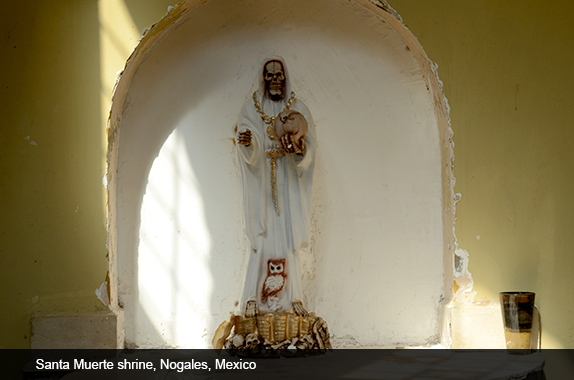
“I may be big but I’m very scared,” Jorge answers as we work our way through narrow streets in the Tepito district of Mexico City, searching for either the church or the “santuario” of La Santa Muerte (the Saint of Death). We’ve heard that this increasingly popular saint is the protector of drug users and dealers and want to get the real story. Jorge is a highly successful Mexico City lawyer but, most important, he is big and powerful looking.
I first read about La Santa Muerte in a 2008 New Yorker article, “Days of the Dead, the New Narcocultura”, by Alma Guillermoprieto. She said that, “The cult is known for the drug traffickers’ devotion to it ...” Describing her visit to the sanctuary in Mexico City, she continues. “Along the edges of the packed street, young men took quick snorts of glue and sometimes wept. A thin tattooed and pierced man with terrible skin was the only one of many toughs who was willing to talk to me, and his amiability may have had something to do with the fact that he had just absent-mindedly assembled a joint about the size of a Robusto and was now wreathed in its smoke.”
Mexico has been going through a terrifying drug war with thousands of unsolved murders. If the drug dealers or narcos have their own saint, La Santa Muerte, it will make it even more difficult to bring this under control.
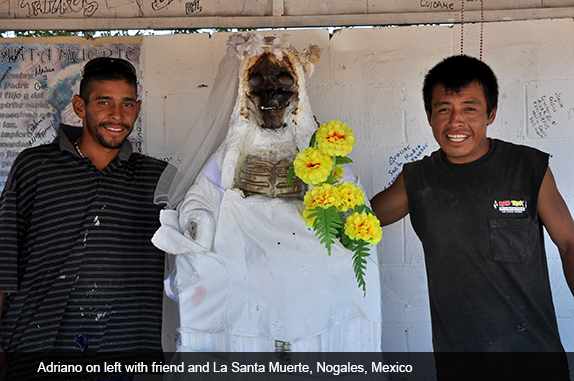
Now we’re on the narrow Calle Bravo and the church suddenly appears in front of us. It’s actually nothing more than several street-front rooms with a shrine to the rear. Inside, a young woman named Yolanda stands behind a glass topped counter selling candles, incense and souvenirs. A small parade of worshipers enter, bow to the Santa Muerte, ring a small bell, pray briefly, make an offering and leave. Off to the side, an older woman is selling more candles. Outside a man named Alvaro and his son and daughter sell plastic skulls, bracelets, even a booklet about La Santa Muerte by a writer named Juan Ambrosio. Alvaro tells us that La Santa Muerte has no particular connection to drug use and the small trickle of worshippers certainly don’t look like drug dealers.
Early the following morning, we’re back in Tepito, an area described by CNN as, “one of the most infamous in the country, home to a flourishing black market, poverty and extensive crime.” It seems peaceful, however, perhaps since it’s only 8 AM. (On a second visit, when we ask two police officers for directions, they insist on escorting us to the sanctuary and wait nervously while we visit. Our driver says that, although the police presence is enormous in central Mexico City, they stay on the major streets and rarely venture into areas like this.)
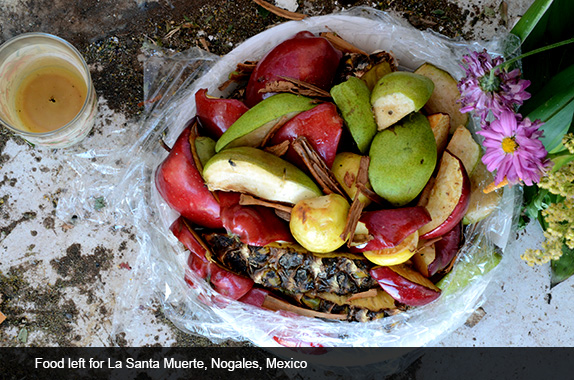
At the santuario, a middle aged man named Raimundo washes the floor in front of the glass partition that contains the saint while his white dog watches. Two young women, Jaqueline and Juana come to pray. Soon Raimundo is setting up his display of souvenirs – pins, key chains, bracelets, statues of the Saint. Several thousand people visit every day, he says, so the souvenir business is probably a booming one.
He makes a scoffing sound when I ask about a connection between La Santa Muerte and drug dealers. Then he waves me into the shop where I see a plastic covered bust of a serious looking man with dark hair and a mustache.
“Who is that? “ I ask.
“Oh, that’s Jesús Malverde,” Raimundo says.
“Who is Jesús Malverde?” I ask.
“Don’t you know? He’s the real saint of the drug dealers.”
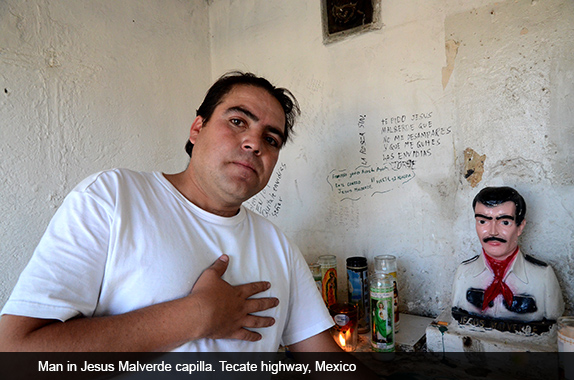
Since those early visits, I’ve seen La Santa Muerte in Juárez, outside Palomas, in a series of little capillas south of Nogales and in a big santuario in Tijuana. Jesús Malverde is harder to find but there’s a little capilla along the highway from Tijuana to Tecate where worshippers are always stopping.
Almost everyone I see at these shrines is willing to talk about their devotion and to be photographed. Here are some of their comments.
When I first stop at the capillas south of Nogales, a battered truck comes crashing off the highway and two young guys jump out. This could be trouble, I think, but they turn out to be very friendly. One of them, Ariano, says that the Santa Muerte is for people who have “real problems.” She doesn’t necessarily have anything to do with drugs, he adds.
Lorena Mendoza lives on the outskirts of Tijuana in a two story house. On the bottom floor, she maintains a large statue of the Santa Muerte in a big glass case. “I’m a Catholic,” she says, “but the Church always wants money. You even have to pay for the final Mass.” So she has turned to La Santa Muerte and maintains it for the whole neighborhood. While remodeling this lower floor, she moved it temporarily to another location. Her nephew, Humberto, age 15, takes me to see it. “I have always believed in La Santa Muerte,” he says.
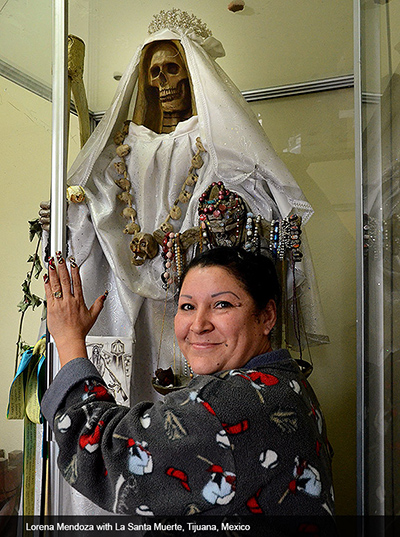
Along the highway between Tijuana and Tecate, there is a little Jesús Malverde capilla. I’ve stopped there three mornings and there is always someone sleeping on the floor. In addition, cars stop and men jump out to say a quick prayer. “We’re long distance drivers,” one of them tells me. “He protects us on the highway. That has nothing to do with drugs.”
La Santa Muerte has a long but unclear history as part of Mexico’s reverence towards death. Jesús Malverde is a mythical folklore hero who allegedly lived in the state of Sinaloa, robbing the rich and giving to the poor – a Mexican “Robin Hood.” Supposedly he was killed by the police on May 3, 1909.
Yes, I’m sure that there are narcos who look to them for protection but the story is much more than that. It’s about people of all types and professions who are seeking help and can’t find it in the orthodox ways that we take for granted.
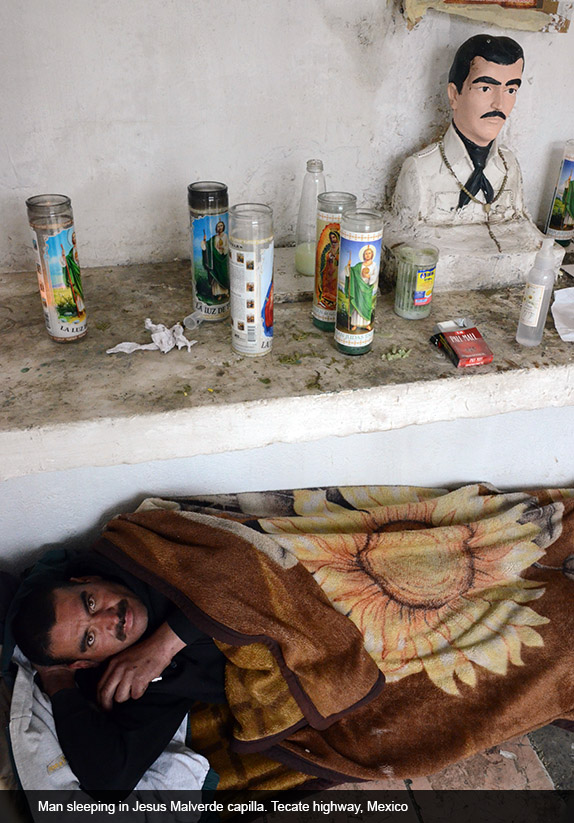



Responses to “La Santa Muerte and Jesús Malverde: Narco Saints?”